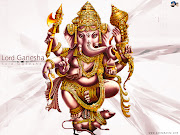Ganesha
IAST: Gaṇeśa; ![]() listen (help·info)), also spelled Ganesa or Ganesh and also known as Ganapati, Vinayaka, and Pillaiyar, is one of the best-known and most widely worshipped deities in the Hindu pantheon.[5] His image is found throughout India.[6] Hindu sects worship him regardless of other affiliations.[7] Devotion to Ganesha is widely diffused and extends to Jains, Buddhists, and beyond India.[8]
listen (help·info)), also spelled Ganesa or Ganesh and also known as Ganapati, Vinayaka, and Pillaiyar, is one of the best-known and most widely worshipped deities in the Hindu pantheon.[5] His image is found throughout India.[6] Hindu sects worship him regardless of other affiliations.[7] Devotion to Ganesha is widely diffused and extends to Jains, Buddhists, and beyond India.[8]
Although he is known by many other attributes, Ganesha's elephant head makes him easy to identify.[9] Ganesha is widely revered as the Remover of Obstacles[10] and more generally as Lord of Beginnings and Lord of Obstacles (Vighnesha, Vighneshvara),[11] patron of arts and sciences, and the deva of intellect and wisdom.[12] He is honoured at the start of rituals and ceremonies and invoked as Patron of Letters during writing sessions.[13] Several texts relate mythological anecdotes associated with his birth and exploits and explain his distinct iconography.
Ganesha emerged as a distinct deity in clearly recognizable form in the 4th and 5th centuries CE, during the Gupta Period, although he inherited traits from Vedic and pre-Vedic precursors.[14] His popularity rose quickly, and he was formally included among the five primary deities of Smartism (a Hindu denomination) in the 9th century. A sect of devotees called the Ganapatya, (Sanskrit: गाणपत्य; gāṇapatya), who identified Ganesha as the supreme deity, arose during this period.[15] The principal scriptures dedicated to Ganesha are the Ganesha Purana, the Mudgala Purana, and the Ganapati Atharvashirsa.



Post a Comment